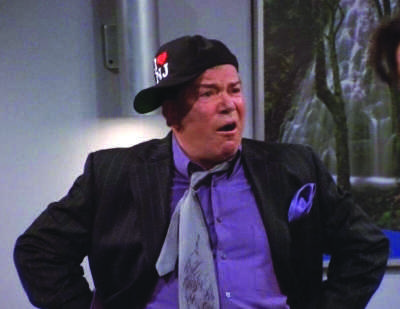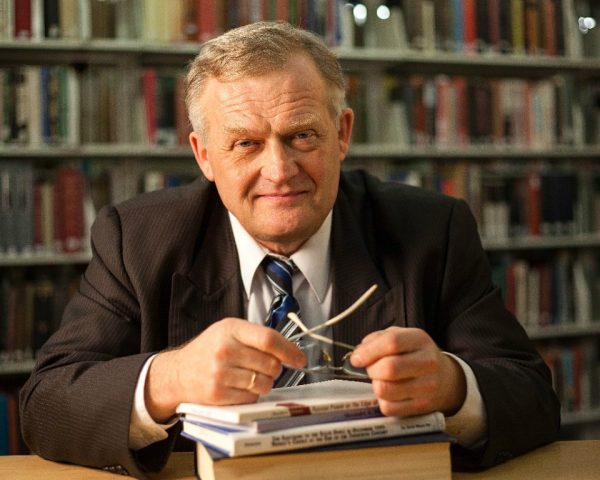“Shatner’s World” celebrates a strange star’s trek

Shatner on the sitcom “Third Rock from the Sun”
They gathered like eager Christians ready for communion. They gathered like the throng of the called at the end of Spielberg’s “Close Encounters of the Third Kind,” anticipating the incomprehensible: extraterrestrial contact. That happened at Devil’s Tower in Wyoming. This happened in the middle theater at the Palace 9 in Burlington. It was seven in the evening on Apr. 24, and they were shifting at the edge of their cushioned seats.
Then darkness fell. An otherwordly, giant patriarch, like the so-called “God” found at the edge of the galaxy in “Star Trek V: The Final Frontier,” apparated before the devout. His low voice, impeccably measured, like sugar in a Betty Crocker recipe, shook the dark.
“Hello.” He politely nodded and smiled, staring into their beings. “I’m William Shatner.”
Everyone laughed.
The digital sign before the theater read “SHATNER’S WORLD,” as if once the doors closed, the assembled would beam up into a strange new planet. In fact, “Shatner’s World” is formed from one cataclysmic element too big, in multiple senses, to squeeze into the periodic table: William Shatner, who was inhabiting theaters across the country for just one night and 90 electric minutes.
“Shatner’s World” is Shatner’s one-man show, which toured the country from November 2012 to February 2013, just before Shatner turned 82. Accompanied only by his “co-chair” – which, Shatner is delighted to observe, is a literal chair, on which he plants his famously rotund bottom less often than you can imagine – Shatner shares chronological reminescences, highlighting absurd scenes from his life, from his first experience with drama to his frantic chauffering of a rabbi and his wife from Vancouver to Chicago before sundown, from his near-castration at the steely hands of a gorilla to an epiphany upon nearly being crushed by a falling horse. He jokes about his supporting cast, verbally farting in George Takei’s direction before five minutes are up. And he “sings.”
All of this may seem more stale than “Golden Girls” re-runs, but not if you know Shatner. People who know the name know he was Captain James Kirk on “Star Trek” and in six-and-a-half of the “Star Trek” movies, as well as an animated series in the 70s.
They might also be aware that he played the flamboyant lawyer Denny Crane on “Boston Legal,” which finally convinced the bourgeois to stop withholding his Emmy Award.
Some might even remember Shatner on the Eighties crime series “T. J. Hooker,” with Heather Locklear, or they might simply know him as the pudgy, whiskey-voiced and svelte “Priceline Negotiator.”
He’s remembered for his stilted performance, beginning a passage of dialogue with urgency, only to abruptly pause, mid-sentence only in the best scenarios, before ejaculating a burst of emotion – and repeat. The highs and lows of emotion in Shatner’s performances are like an erratic cardiogram. This has surrounded Shatner with an aura of camp, which he has come to gracefully wear like the unrivaled toupees adorning his head since the 60s. Recognizing that campy aura, which is almost always glazed over Shatner’s image in discussing his roles, many people interpret his radically unorthodox acting as amateur and awful.
That seems like a reasonable interpretation, considering popular models of great acting: the simmering restraint of Laurence Olivier, the subtle tension of Robert De Niro, the coursing anger of Al Pacino. See any similarities? How about controlled emotion?
The emotion in Shatner’s performances is completely uncontrolled – no wonder these performances are considered the antithesis of good acting. William Shatner’s style of performance is something like emotional Tourette’s.
“Shatner’s World” is sprinkled with clips from Shatner’s ouevre. In one clip, the incessantly driven and optimistic Captain Kirk wonders over the beauty of risk.
Now imagine these other great actors doing the scene. Olivier would smoke his way through the soliloquoy, gazing romantically into the distance, imagining humankind carrying onward and upward. De Niro, he’d play it like a guy in a diner, gradually growing a smile, telling it like he feels it. Pacino would smile sadly, as if remembering a childhood dream he can’t stop believing in.
Here’s how Shatner does it. The scene in question is from “Return to Tomorrow,” an episode from the second season of “Star Trek.” Captain Kirk and his senior officers are pondering an extremely risky decision that might put them all in danger – a standard “Star Trek” scene. But “standard” is in a separate universe from Shatner’s performance.
“Do you wish,” Shatner begins, a sudden burst of aggression. His mouth slinks into a smile, eyes burning. He ends the sentence: “—that the Apollo mission hadn’t reached the moon? Or that we hadn’t gone on to Mars, and then the nearest star.” He sits a moment, staring into his fellow officer as if staring down his feelings. He suddenly exclaims, “That’s like saying you wish you still operated with scalpels, or sewed your patient up with catgut like your great – great – great – grandfather used to.”
Again he stares. His posture, the way he shifts his attention as his mind runs, eminates the heat of internal burning. “I’m in command,” he spits, as if swallowing a hard truth. “I could order this.” He sits up and barks, “But I’m not!” He blinks. He shifts, sitting up.
“Because –” He wags his finger and shifts again, struggling to translate feeling to words. “—Doctor McCoy is right!” The words are out; he shifts again, still burning. He adds, “In pointing out the enormous danger potential” (barking each word as if they themselves were dangerous) “in any… contact with life and intelligence” (he raises his finger for emphasis, slamming it down as he says) “as fantastically advanced as this, but I must point out” (he raises his fist, gritting his teeth, eyes watering, shaking his fist like our ancestors slammed hammers) “the potential for knowledge and advancement…” He pauses, his expression slackening, eyes widening with a sense of what he’s saying. He bursts out, “is equally great!”
He sits there, unmoving, the core feeling expressed. He sits back, recollecting himself, as a smile takes over his face. His eyes twinkle as he continues, “Risk… risk is our business!” Another pause. “That’s what this” (he looks up as if to the stars) “starship is all about!” He looks to his officers again, firm. “That’s why we’re aboard her!”
After this speech, he puts risky contact with this alien species to a vote. His crew members, awed into silence, are all in favor.
There’s no doubt Shatner’s fan base was watered by the flabbergasting uniqueness of Shatner’s acting, which is so absurdly unorthodox one has to laugh, but the seeds were planted by the contagious wonder and love of emotion in his performances.
Shatner is also intentionally hilarious. For one thing, he’s shameless. He drops crude gags at inopportune times, grinning smugly but with no sense of others’ reactions – he just seems to be enjoying himself.Take, for example, his stab at George Takei in “Shatner’s World.”
Shatner was “roasted” by his friends and eternally loathing co-stars in a “Comedy Central Roast” that aired in 2006. Shatner’s closest friend is his co-star Leonard Nimoy, who played Spock, despite a famously rocky beginning to their relationship. Shatner was also good friends with DeForest Kelley, who played Dr. McCoy, and passed away in 1999. The rest of his “Star Trek” co-stars loath him, accusing him of hogging the fame and having an ego the size of his fluctuating gut, but no one loathes Shatner more than George Takei, who played helmsman Hikaru Sulu.
Takei has launched frequent and aggressive verbal assaults on Shatner, who typically responds with a joke, a smile, and a message of peace. No doubt Takei’s upset is warranted, and I don’t mean to angelicize Shatner, but his perpetual levity is much of his charm.
During the “Comedy Central Roast,” Takei rode in on a horse before settling to lambast Shatner. At the beginning of “Shatner’s World,” Shatner reviews footage of Takei’s roasting. Shatner’s eyes bug out, his face a frenzied scowl.
Shatner quips, “Finally, I can tell George Takei something I’ve always wanted to say: ‘F—k you and the horse you rode in on!!’”
Levity is what keeps Shatner afloat: it’s what prevents him from capsizing under the weight of his mythic ego. But one has to wonder if his ego’s mythic proportions are just that: a myth. It’s hard to imagine this frequently overweight, self-mocking, wisecracking adventurer – more on that in a minute – taking himself too seriously. He adds humor for punctuation in any sentence he can, and rarely at anyone’s expense, unless anyone is George Takei.
Yet Shatner is also prone to moments of sudden and profound existentialism. He’s spent a career distancing himself from Captain Kirk, but like Kirk Shatner too is hung up on cosmic wonder.
In his books, public talks, albums and talk shows, Shatner has shown a preoccupation with death and dying, with assigning meaning to existence. Shatner’s musings on life and death aren’t heavily ponderous and tinged with depression, but light and colored with awe.
At one point in “Shatner’s World,” Shatner recalls nearly being crushed by a falling horse. His leg was broken, and he was lying on the ground, waiting for medics. He had just been asked to play Captain Kirk in the controversial 1994 film “Star Trek: Generations,” which introduced the cast of the second “Star Trek” series, “The Next Generation,” and shamelessly and clunkily murdered Shatner’s Kirk.
In “Shatner’s World,” recounting his experience with the falling horse, Shatner says that as he lay there on the ground, he knew how to play the death scene of the man who made him.
“I thought – ‘Oh my god,’” Shatner recalls, “This is how Captain Kirk would die. He would try to get up, and fall back down. He would try again. Fall back down again. He would keep trying to stand, until finally, he would just fall – and lying there, on the ground, he would bathe in it, he would absorb death. Even death is an adventure for Captain Kirk. What would he see?”
Those are the emotional elements that constitute Shatner’s success: simple questioning, simple joy. He was 81 at the time “Shatner’s World” was filmed, but seemed more youthful and playful than ever, shuffling and sliding across the stage with the grace of a man 30 years younger and 50 pounds lighter.
It’s Shatner’s wonderful simplicity that makes him profound. Is there anything more profound than simple happiness in a world with absurd diseases that can strike at any time and eat us from the inside out, a worldin which we try to rush each other’s inevitable demise, a world that ends our story by killing its protagonists?
William Shatner is, ironically, keenly aware that this is not Shatner’s world – or anyone else’s.
“Shatner’s World” culminates in a performance from Shatner’s second album, “Has Been,” released in 2004. Shatner wrote the lyrics for each “song,” Ben Folds wrote the music.
Shatner’s comic mystique began to develop when he released his first album, “The Transformed Man,” in 1968. The concept was to juxtapose classic literature, mostly Shakespeare, with thematically identical popular music from the time, like Bob Dylan and Frank Sinatra. The product is outrageous.
His second album, on the other hand, is a tremendous success. The ending song, “Real,” was co-written by country star Brad Paisley. It’s “Real” that ends “Shatner’s World,” over a slideshow of Shatner riding bulls; Shatner shaking hands with Coco the Gorilla; Shatner and his three chipper daughters; Shatner wearing a goofy fishing hat; etc.
“And while there’s a part of me/In that guy you’ve seen/Up there on that screen/I am so much more,” Shatner says, over the music.
“And I wish I knew the things you think I do/I would change this world for sure/But I eat, and sleep, and breathe, and bleed, and feel – sorry to disappoint you: I’m real.”





